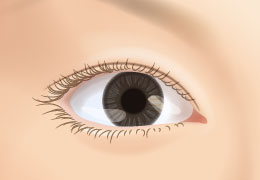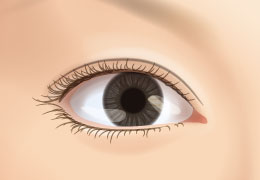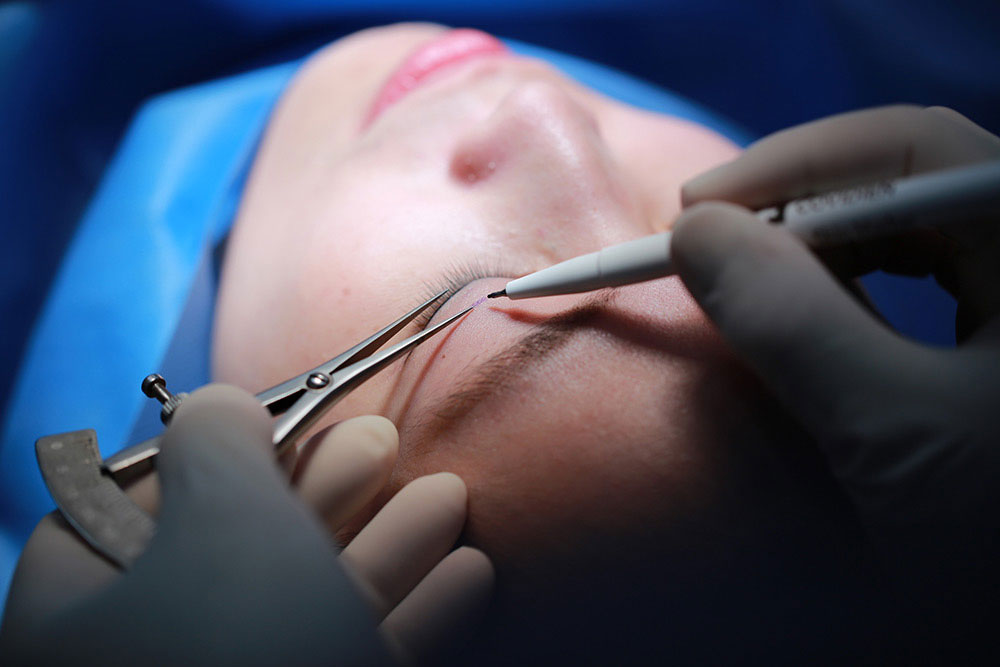Surgical Concept
Blepharoplasty (eyelid surgery) is the most common plastic surgery in Taiwan. Because it is able to enlarge the eyes and sharpen eye expression, it is generally considered as the first step in facial plastic surgeries locally. Selecting a safe procedure with natural result is the greatest preoperative concern for many patients. Nevertheless, because the congenital eyelid structure is relatively exquisite and the eyeball curvature, levator palpebrae muscle strength, eye shape or length, and eyelid skin thickness differ to some extent, the evaluation should be more accurate; otherwise, any factor can undermine the surgical results. Therefore, the most important part of the preoperative communication between Dr. Chuang and his patient is to recommend and offer a customized surgery under the precondition that the patient’s requirements are satisfied.
The eyelid appears like a thin layer of skin but is actually made up of several layers: from the superficial skin, dermis, subcutaneous fascia, orbital fat, levator palpebrae aponeurosis, and levator palpebrae muscle to the deepest tarsal plate, which all assume different functions. Physicians should not only familiarize themselves with the characteristics of these physiological structures but also understand their mutual connections to correct the various palpebral problems of patients. In spite of the fact that eyelid surgeries are not varied quite much, the surgical design and physician’s esthetic outlook determine the surgical results. Dr. Chuang not only reproduces high/low or deep/shallow creases during double eyelid surgery but also takes into account the correlation between the following individual variables and proportions to sculpt a pair of charming double eyelids.
Esthetic Design of Double Eyelids
Dr. Chuang considers that blepharoplasty is designed based on producing eyelid folds and should be consistent with the 1:2:3 or 1:2:2 ratio of the medial canthus/lateral canthus height ratio to allow the eyelid folds and eyeballs to properly match and the double eyelids to present natural results, which are then less likely to cause unsmooth or unstable eyelid folds (multiple lines) or even iatrogenic ptosis. In addition, the eyelids can be classified into the parallel types of Westerners, where the eyelid crease is completely exposed form the starting point of the medial canthus to the lateral canthus or the common almond types (Phoenix eyes) of Orientals, where the double eyelid crease is covered at the medial canthus and gradually elevated to the lateral canthus. Either result can be achieved by surgery regardless of the patient’s preference. Therefore, Dr. Chuang first evaluates the characteristics of the eyelids of each individual during consultation by on-site simulation with a special tool before giving a suggestion about the double eyelid pattern and surgical method.

Almond types (Phoenix eyes) Double Eyelids

Parallel types of Westerners Double Eyelids
Essential Reduction of Inter-canthal Space
Orientals generally have a wide inter-canthal space, which makes their eyes appear lusterless or less concentrated. The skin covering the inner corner of the eye is frequently called the epicanthal or Mongolian fold. It has no special function but affects the eye size and shape or even blepharoplasty results, interfering with the medial canthus fold of the open double eyelids. Therefore, Dr. Chuang suggests that if necessary, medial canthoplasty (or epicanthoplasty) should be simultaneously conducted with blepharoplasty. This not only enlarges the eyes but also shortens the interocular distance to achieve the golden ratio of an equally wide eyeball and eye span, which makes the eyes more concentrated and brighter and adds finishing touches.
Detail Evaluation of Brow–eye Distance
The distance between the eyebrow and eye gradually becomes less due to the sagging and drooping of forehead skin, which is commonly called “brow compression upon the eyes” (eyebrow downward compression makes the eyelids droop more). This problem worsens with aging, so the skin elasticity and looseness of the forehead and eyebrow should be concurrently evaluated on aging. Otherwise, these problems will occur as postoperative excessively deep eyelid folds, compensatory ptosis, or impersistent results. Generally speaking, if the brow–eye space is still more than 1.5 cm, simple blepharoplasty is conducted to modify eyelid drooping effectively. However if the brow–eye distance is less than 1 cm or the eyebrow and eye tail have presented obvious drooping (such as slanted eyebrows), the results of simple blepharoplasty are relatively limited and unnatural, then Dr. Chuang recommends that patients to consider undergoing forehead or eyebrow lift alternatively, which integrates the double eyelid naturalness and persistent results for achieving relatively obvious improvement.
Well Proportion of Medial and Lateral Canthi
In clinics, the problems of eye shape in some patients do not lie in eye size or double eyelid pattern but rather in the disproportion of the medial and lateral canthi, which disables the bilateral sides of the eyeball horizontal axis to achieve perfect balance. This problem is predominantly hereditary or congenital. In accordance with the standard ratio of big eyes, the distance between the white flanking the black (pupil) and the medial or lateral canthus is appropriately consistent, which renders the eyes with a quasi-semicircular appearance and an approximate 1:1 ratio between the area of the black to the visual area and that of the white. A disproportionate black and white eye causes a typical small eye appearance such as Phoenix eye (excess covering of the medial canthus and overtly short lateral canthus) or almond-shaped eye (both the medial and lateral canthi are short, with the eyes like a copper bell). In the meantime, during the evaluation for blepharoplasty, the patient may consider concurrently accepting medial or lateral canthoplasty, which redresses congenital eye shape defects to make the ocular length and width ratio close to the perfect ratio of 1.5:1 and avoids the visual gap of rounder and shorter eyes due to the elevation of the double eyelids. Moreover, lateral canthoplasty curtails the distance between the corner of the eye tail and lateral side of the zygomatic bone to let the eyeball length/facial width ratio move closer to the golden standard, thus achieving the ultimate goal of enlarging the eyes.
Surgical Characteristics
Minimally Invasive Double Eyelid Surgery
Wounds and scars caused from the traditional full-incision double eyelid surgery used to leave visible marks on numerous patients and therefore deter many beauty-loving girls who could not overcome the psychological barriers of possible scarring that arises from the surgery. Along with refinements and improvements to cosmetic surgeries, Dr. Chuang has extensively applied the devices and sutures of microsurgeries in the new minimally invasive double eyelid surgery (upper blepharoplasty). Independent of whether patients receive half-incision or tri-point micro-incision surgery, Dr. Chuang attempts to shrink the incision to the smallest size to avoid future scarring and accommodate long-lasting and stable results. These minimally invasive surgeries are characteristic for small wounds, which not only mitigate trauma to tissues but also enable the postoperative swelling to subside faster and reduces the recovery period by half or less; therefore, these surgeries are popular and indicated particularly among young people. As long as an accurate evaluation and a meticulous operation are performed, the overwhelming majority of patients will enjoy the convenience and benefits brought about by such minimally invasive surgeries, synchronous with modern Korean techniques.

Applications of microsurgery techniques greatly reduces recovery time and complications.
Medial and Lateral Canthoplasties
The medial canthus (Mongolia fold) plays a crucial role in blepharoplasty among Orientals and even confers multiple effects on the eyes, so the necessity of medial canthoplasty (or epicanthoplasty) should also be considered in the evaluation for double eyelid surgery. Dr. Chuang excels in the assessment of the proportion between the medial canthus and the interocular span and performs the relatively difficult but more naturalistic W-plasty medial canthoplasty, which not only flexibly adjusts the running direction of the medial canthus and degree of opening in light of the patient’s requirements but also avoids complications such as fox’s eye, excessive concentration (cross eye), or exposure of the lacrimal caruncle caused by the traditional direct cutting procedure. In this way, the medial canthus and marginal eyelid accurately connect to form the parallel double eyelid fold, shorten the interocular distance, and widen the eyes. Meanwhile, for a minority of patients who do not require a substantial correction of the medial canthus, Dr. Chuang also provides Z-plasty medial canthoplasty as another option to prevent excessive opening. Regarding lateral canthoplasty, despite not being indicated for everyone, Dr. Chuang conducts a relatively complex lateral canthal V-Y extension flap for some patients with a short lateral canthus, small round eyes, or an upturned lateral canthus. Such a surgery elongates the lateral canthus to make the eyeball much bigger and confers the effects of lateral canthopexy instead of causing scar retraction, which is common in traditional lateral canthus cutting. Thus far, it has prolonged and stable effects and amounts to the safest and most effective lateral canthoplasty.
Levator Palpebrae Muscle Correction
The levator palpebrae muscle is an important structure that controls the opening and elevation of the palpebrae superioris. It plays a role of whether it can allow the complete exposure of the eyeballs and also affects the height and naturalness of the eyelid fold after blepharoplasty, which should not be neglected. However, because it is located at the deepest layer of the eyelid, the levator palpebrae muscle is commonly covered by a thick monolid or fat and thus camouflages latent ptosis (myasthenia). If the preoperative evaluation is incomplete or misdiagnosed, asymmetrical or uneven eyes are commonly induced and secondary blepharoplasty will be necessary for severe cases. Therefore, Dr. Chuang routinely examines the functions of the patient’s levator palpebrae muscle before surgery, and in case of possible ptosis recommends the simultaneous correction of the levator palpebrae muscle to ensure the symmetry of the bilateral eyelids. Moreover, because congenitally excessively small eyes or overt eyelid drooping renders the eyes lusterless (lazy eyes), simple levator palpebrae muscle correction, the palpebral fissure surgery is applied in conducted along with double eyelid surgery to raise the horizontal level of superior eyelash line by special internal suturing on levator palpebrae muscle, thus completely revealing the eyeballs and showing the optimal effects of enlarging the eyes esthetically.
Fat Translocation and Restoration
Palpebral fat is dynamic and may atrophy or become protrusive with time and aging. Therefore, the trade-off between age and fat should be taken into account during double eyelid surgery to avoid orbital or pouch depression due to excess eyelid fat removal. Because Orientals have thick eyelids and relatively lower eyebrows, partial eyelid fats are generally removed during double eyelid surgery. However, for patients with congenital exophthalmos or almost loose or sagging upper eyelids, Dr. Chuang transfers the fat below the lateral brow to fill the superior medial eyelid pouch rather than discard it, which effectively supports the upper eyelid and rebalances the distribution of orbital fat to help prevent secondary eyelid sinking. In addition, for lower eye bag surgery, Dr. Chuang adopts the latest autologous fat graft by transferring the existing protrusive pouch fat to the tear trough groove and by repairing the septum, which not only simultaneously solves the problem at the lower eye bag and depressed tear trough groove but also confers completely smooth appearance of entire lower eyelid with long-lasting effects. Furthermore, this is less likely to cause complications such as postoperative sunken eyelids or short-term recurrence, which are possible from simply eye bag removal surgeries.
